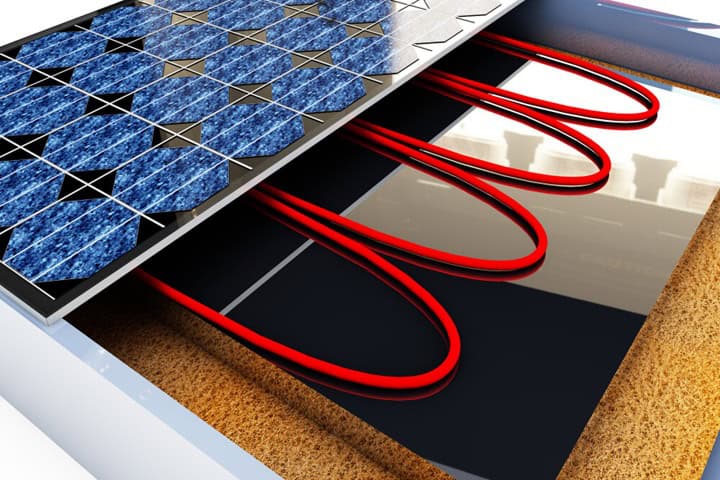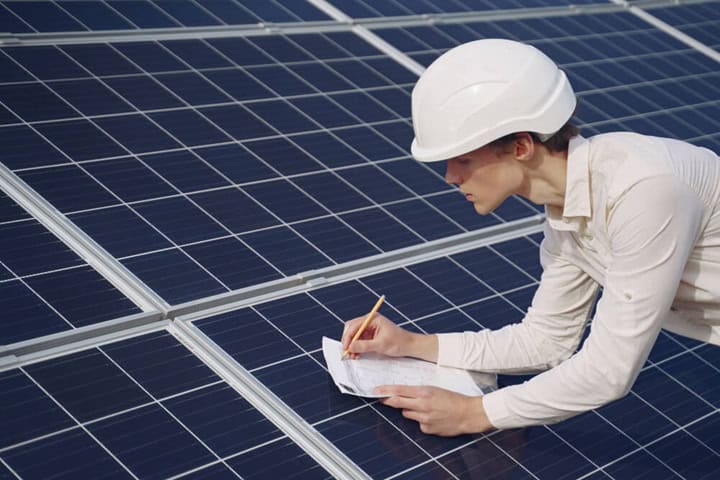Renewable heating is the future! Find out how you can integrate underfloor heating with solar panels in this in-depth guide.
We can continuously searching for renewable energy options, cutting down on fossil fuels and reducing our carbon footprint. But what about our heating? Is it possible to heat your home without the need for gas and electricity? Today, you will find out the answers, for in this article, we will discuss the warmth and efficiency of solar-powered underfloor heating by exploring how solar underfloor heating works, comparing wet and electric systems, and delving into their benefits, installation, and running costs.
What is Solar Underfloor Heating?
Solar underfloor heating involves solar panels absorbing heat from the sun to provide a comfortable, radiant heat throughout your home, upon being integrated on a stable platform, usually on the roof. This eco-friendly option comes in two forms: solar thermal and solar photovoltaic (PV) systems, each compatible with different types of underfloor heating—wet and electric.
Whether you opt for a solar thermal setup that heats water or a solar PV system that generates electricity, both can effectively power your underfloor heating, offering a sustainable way to warm your living spaces. To improve your understanding of how your home can benefit from natural solar heat, discover the concept of what solar gain is and its impact on heating.
How Solar Powered Underfloor Heating Works
Solar underfloor heating systems utilise the entire floor surface as a radiator, distributing heat evenly across the room. Unlike traditional radiators that heat air (convection heating), underfloor systems emit radiant heat that warms objects and people directly, creating a more uniform and comfortable environment.
Types of Solar Underfloor Heating Systems
Much like how you can integrate underfloor heating with ground source heat pumps, and wall heaters, to name a few, there are two types of underfloor heating systems that you can add to solar panels:
Solar Powered Wet Underfloor Heating System
Ideal for new constructions, wet underfloor heating involves circulating heated water through pipes laid under the floor. These systems can be powered efficiently by both solar thermal panels, which heat water directly, and solar PV panels, which produce electricity to heat water. The layout of the pipes ensures even distribution of heat, making it suitable for stone or tiled floors which have high thermal conductivity and help in distributing the heat uniformly.
Solar Powered Electric Underfloor Heating System
For smaller retrofit projects or specific rooms like bathrooms, electric underfloor heating is an excellent choice. This system uses electric heating mats or cables installed under the floor surface to convert electricity—generated from solar PV panels—into heat. While electric systems are typically more expensive to run than wet systems, using solar panel underfloor heating significantly reduces these costs, making it a viable and eco-friendly option.
8 Benefits of Solar Panels with Underfloor Heating
Integrating solar panels with underfloor heating not only maximises the energy efficiency of your home but also offers a cleaner, safer heating solution…
1. Space Efficiency
Traditional radiators can be bulky and often dictate the layout of a room. Solar underfloor heating, however, is hidden beneath the floor, freeing up wall and living space, allowing for greater freedom in interior design and decoration. This system not only saves space but also improves the aesthetic appeal of your home, eliminating unsightly radiators.
2. Comfort
The comfort provided by solar underfloor heating is superior to traditional systems. It heats the room evenly, eliminating cold spots and ensuring a consistent temperature from floor to ceiling. This method of heating is particularly appreciated during the colder months, as it provides a warm surface underfoot—ideal for homes with tile or stone flooring.
Find out which flooring is best for your home with our guide on porcelain or ceramic tiling.
3. Cost
Solar panel underfloor heating is highly efficient due to its method of even heat distribution at lower temperatures. The integration of solar panels allows for the generation of free, renewable energy, substantially reducing running costs. Over time, the initial investment in solar underfloor heating can be recouped through lower energy bills and minimal maintenance costs.
For more information about prices, check out our information about the cost of bathroom underfloor heating.
4. Environmental Benefits
Choosing solar powered underfloor heating reduces your carbon footprint. Solar energy is a clean, renewable resource that decreases dependency on fossil fuels. Additionally, underfloor heating systems are known to be up to 20% more efficient than traditional heating systems, further reducing energy consumption and emissions.
5. Health and Safety
Solar underfloor heating promotes a healthier indoor environment by minimising air movement and reducing the circulation of dust and allergens. This is particularly beneficial for those with allergies or respiratory issues. Moreover, unlike radiators that can pose burn risks, especially to young children, underfloor heating provides a safe, touch-friendly solution.
Learn more on how underfloor heating can reduce challenges caused by heat and asthma.
6. Economic Considerations
While the initial setup for solar underfloor heating, particularly with wet systems, might be higher due to the cost of materials like pipes and manifolds, the long-term savings on energy expenses make it an economically sound choice. Whether you opt for a wet or electric system, the integration of solar panels significantly offsets ongoing costs, making it a worthwhile investment for those renovating or building new builds.
7. Installation Costs
The installation costs of solar underfloor heating systems vary significantly between wet and electric options. Electric underfloor heating systems are more economical for a standard 60m² house, with installation costs varying from £240 to £480 for new constructions and £480 to £720 for refurbishments. On the other hand, wet underfloor heating systems are more expensive because of their intricate installation process, with prices ranging from £960 to £1440 for new constructions and £1,200 to £1,680 for refurbishments. Wet systems require additional steps such as testing the water flow and pressure and waiting for screed layers to dry, which adds to the labour and time costs.
The choice between wet and electric systems depends not only on your budget but also on the type of property, floor covering, and your geographical location. Contact us today for a personal quote.
8. Performance in Winter
One common concern is the effectiveness of solar-powered underfloor heating during winter when solar energy is less abundant. Although solar thermal systems can provide around 25% of a household’s hot water needs in winter, and solar PV outputs decrease significantly, most systems are designed with backup solutions. These may include using grid electricity or integrating with other renewable energy systems to ensure continuous heating during less sunny days.
When living off the grid, it can be more difficult to heat your home. Read our guide on how to heat your off grid home for the right solutions.
Calculating Your Solar Energy Needs
When planning to install solar underfloor heating, determining the amount of solar energy required to efficiently heat your home is essential.
The amount of solar energy needed for solar powered underfloor heating varies based on several factors. Key considerations include the insulation quality of your home, the size and efficiency of the installed photovoltaic (PV) system, and your typical heating needs. Homes with high levels of insulation and efficient solar panel systems may reach near total energy independence. Here’s a quick breakdown:
- Fully Off-Grid Homes: These homes can cover 100% of their annual heating demand with solar energy, ideal for well-insulated properties with robust solar PV systems.
- Mostly Off-Grid Homes: These properties can achieve up to 80% of their heating needs from solar, with minimal reliance on external energy sources.
- Complementary Solar Homes: For homes integrating solar with other energy forms, approximately 35% of heating can be solar-powered, significantly reducing energy costs and improving efficiency.
Each scenario offers a sustainable way to utilise solar underfloor heating, aligning the installation of solar panels with your specific heating requirements to optimise energy use and cost-efficiency.
Try Out Electric Underfloor Heating With Solar Panels
Solar underfloor heating represents a forward-thinking solution for modern, eco-conscious homeowners. By leveraging solar energy, either fully or partially, you can significantly reduce your reliance on traditional energy sources, decrease your environmental footprint, and enjoy a consistently warm home. Whether opting for a fully off-grid system or a complementary setup, solar underfloor heating provides a reliable, cost-effective, and sustainable heating solution.
FAQs
Can solar power run underfloor heating?
Yes, solar power can run underfloor heating, provided there is a system in place to convert and store the solar energy as electrical power or to heat water.
What is the most cost-effective method to operate underfloor heating?
The most economical way to run underfloor heating is by using a water-based system connected to an efficient boiler or heat pump, especially when combined with solar power or other renewable energy sources.
Does underfloor heating use a lot of electricity?
Electric underfloor heating systems can use a significant amount of electricity, especially in larger spaces. However, they are efficient in their operation and can be less costly if properly insulated and managed with a smart thermostat.
Which is cheaper to run, underfloor heating or radiators?
Underfloor heating can be cheaper to run than radiators when it is powered by efficient systems like heat pumps, especially in well-insulated homes where heat distribution is more uniform.
What is the best floor for underfloor heating?
The best floors for underfloor heating are typically those that conduct heat well, such as tile, stone, and concrete. These materials help distribute the heat evenly and retain it effectively.
Can you heat a whole house with underfloor heating?
Yes, you can heat a whole house with underfloor heating. It is suitable for a wide range of properties and can be installed under various types of flooring to provide consistent, efficient heating.
Should you turn underfloor heating off at night?
It is not necessary to turn off underfloor heating at night, especially in very cold weather. It’s more efficient to lower the thermostat slightly as underfloor heating takes a long time to warm up and cool down.
Sources
Energy Saving Trust. (2022) Renewable heating: what are the options for your home? [online] Available at: https://energysavingtrust.org.uk/renewable-heating-what-are-the-options-for-your-home/ [accessed 07/06/2024]



